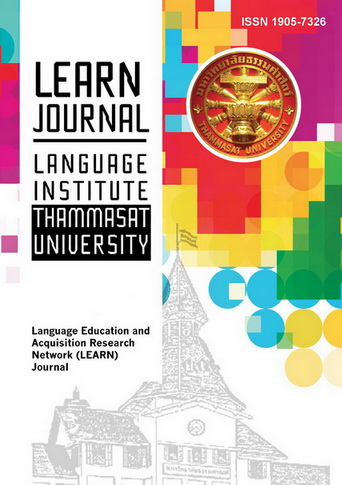Asymmetry between Thai and English passives in L1 Thai learners
Main Article Content
Abstract
The present study investigated the production of English passive constructions among Thai learners as syntactic asymmetry of the construction in question in Thai and English can be attested. In this study, English verbs were categorized into two types: Verb Type 1 and Verb Type 2. The former refers to those that can naturally occur in Thai thùuk passives while the latter includes those that sound unnatural when used with the same marker. Forty undergraduate students, including 20 advanced and 20 intermediate learners, were asked to complete sentences, each of which consisted of at least three given words: one noun placed as the subject, one verb, and another noun. Results showed that it can be assumed that language transfer is a factor leading to high and low numbers of passivization with Verb Type 1 (positive transfer) and Verb Type 2 (negative transfer), respectively, regardless of their groups. Learners’ proficiency levels play a vital role in the number of passive sentences produced in both verb types, showing statistical significance (p < .05). The differences between the verb types, conversely, are not statistically significant across the two groups.
Article Details
References
Chotiros, V., & Pongpairoj, N. (2012). Avoidance behavior among L1 Thai learners: The case of the L2 English passive construction.Proceedings of the International Conference: Expanding Horizons in English Language and Literary Studies (ELLS 2011), 114–124.
Coto Villalibre, E. (2015). Is the get-passive really that adversative? Miscelánea: A Journal of English and American Studies, 51, 13-26.
Crystal, D. (2003). The Cambridge encyclopedia of the English language. CUP.
Downing, A. (2015). English grammar: A university course. Routledge.
Ellis, R. (2015). Understanding second language acquisition. OUP.
Hinkel, E. (2002). Why English passive is difficult to teach (and learn). In E. Hinkel & S. Fotos (Eds.), New perspectives on grammar teaching (pp. 233-260). Lawrence Erlbaum Associates.
Iwasaki, S., & Ingkaphirom, P. (2009). A reference grammar of Thai. CUP.
Kim, K., & Kim, H. (2013). L1 Korean transfer in processing L2 English passive sentences. In E. Voss et al. (Eds.), Selected Proceedings of the 2001 Second Language Research Forum (pp. 118-128). Cascadilla Proceedings Project.
Poonsawad, T. (2013). Acquisition of English passive voice in Thai ESL learners at Kratoo International Home School [Unpublished master’s thesis]. Language Institute, Thammasat University.
Pothipath, V. (2018). Phasathai nai mummong baeplakphasa [Thai in typological perspectives]. Academic works dissemination project, Faculty of Arts, Chulalongkorn University.
Prasithrathsint, A. (1988). Change in the passive constructions in Standard Thai from 1802 to 1982. Language Sciences, 10(2), 363- 393.
Prasithrathsint, A. (2001). The establishment of the neutral passive and the persistence of the adversative passive in Thai. Manusya, 4(2), 77-88.
Prasithrathsint, A. (2004). The adversative passive marker as a prominent areal feature in Southeast Asian languages. In S. Burusphat (Ed.), Papers from the eleventh annual meeting of the Southeast Asian Linguistics Society 2001 (pp. 583-598). Arizona State University, Program for Southeast Asian Studies.
Prasithrathsint, A. (2006). Development of thùuk passive marker in Thai. In W. Abraham & L. Leisiö (Eds.), Passivization and typology: Form and function (pp. 115-131). John Benjamins.
Prasithrathsint, A. (2010). Nuai sang kammawachok [Passive Constructions]. In A. Prasithrathsint (Ed.), Nuai sang thi mi khwamkhatyaeng nai waiyakon thai [Controversial Constructions in Thai Grammar], (pp. 174-266). Chulalongkorn University Press.
Saville-Troike, M., & Barto, K. (2017). Introducing second language acquisition. CUP.
Selinker, L. (1972). Interlanguage. International Review of Applied Linguistics, 10, 209–231.
Siewierska, A. (2005). Passive construction. In M. Haspelmath, M. S. Dryer, D. Gil & B. Comrie (Eds.), The world atlas of language structures (pp. 434-437). OUP.
Simargool, N. (2008). Interlanguage passive construction. Journal of Pan- Pacific Association of Applied Linguistics, 12(1), 97-103.
Somphong, M. (2013). An analysis of error in passive sentence structures by Thai EFL university students. The Asian Conference on Education 2013: Official Conference Proceedings (pp. 662-675). Japan.
Tallerman, M. (2015). Understanding syntax. Routledge.
Timyam, N. (2014). An analysis of learner use of argument structure constructions: A case of Thai learners using the passive and existential constructions in English. Department of Foreign Languages, Kasetsart University.
Timyam, N. (2015). A comparative study of English and Thai: An introduction. Kasetsart University Press.
Voun, S., Intanoo, K., & Prachanant, N. (2017). A contrastive analysis of passive voice errors in English paragraph writing made by Cambodian and Thai EFL University students. College of Asian Scholars Journal, 7, 451-463.
Wang, Y. (2010). Classification and SLA studies of passive voice. Journal of Language Teaching and Research, 1(6), 954-949.


